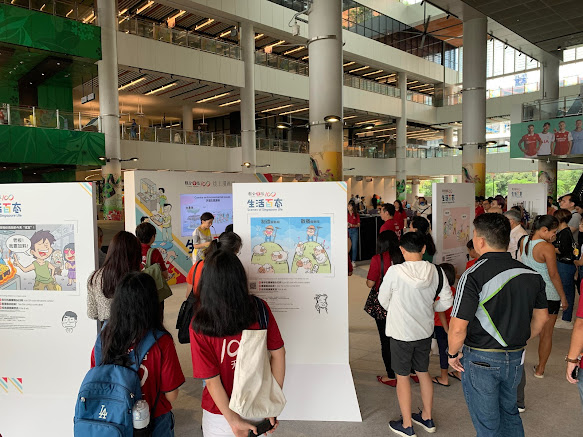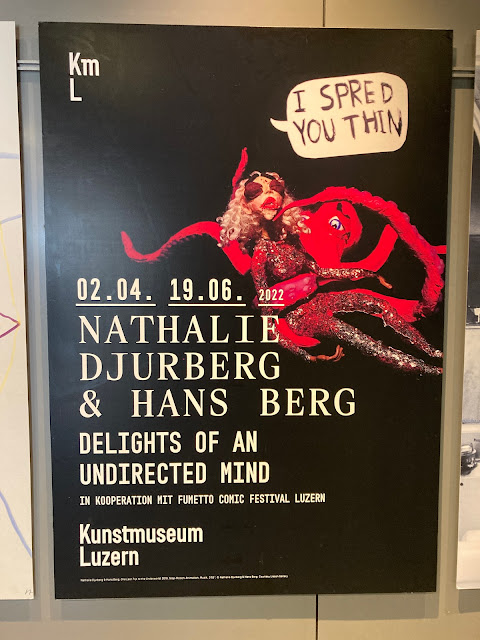JewCE: The Jewish Comics Experience. Tony Kim (dir.). JLTV and Turnkey Pictures, 2024.
JewCE, or the Jewish Comics Experience < https://jewce.org/>, is an annual convention and awards ceremony held in New York City and sponsored by The Center for Jewish History. Its inaugural event in 2023 included the opening of an interactive museum exhibit that is designed to celebrate Jewish comics, cartoons, and graphic narratives and is now traveling around the country. This fall, JewCE released an almost 23-minute video about the exhibit and provided a copy for review.
The narrative arc of the video provides a chronological overview of Jewish comics, cartoons, and graphic novels since the 20th century. With so much to cover in a limited amount of time, viewers are introduced to seminal writers and artists such as Stan Lee and Jerry Siegel, and also to noteworthy figures in comic book history like the publisher Maxwell Gaines and psychiatrist Fredric Wertham. The video is narrated by JewCE’s exhibit curators, Roy Schwartz, Danny Fingeroth, and Miriam Eva Mora who also provide commentary and insights. I appreciated JewCE’s interest in moving beyond a description of what happened in Jewish comics history to an analysis of the importance of what happened. This is a demonstration of the curators’ stated intention to bring together not only artifacts, but to also draw upon history and comics scholarship to inform the exhibit’s content. The video concludes with a section on the exhibit’s interactive features which afford attendees the opportunity to participate in storyboarding and to see themselves as characters in comics.
One of the greatest strengths of the video (and the exhibit itself) is the inclusion of material published by Marvel Comics and DC Comics. Securing permissions can be notoriously tricky (and costly), but the inclusion of these materials provides viewers with strong visual anchors that allow them to see what the narrators are referring to. The inclusion of scenes featuring different characters in animated movies and tv shows was also a nice addition showing the many ways that characters who were originally conceived for print media have evolved over time.
Despite the film’s strengths, I have two concerns and both have to do with the use of superhero narratives. My first is with how Jewishness was read into superhero stories. In its inclusion of Jewish connections to the superhero genre, the three narrators document examples where creators make explicit reference to Jewish themes and topics like the famous cover of Captain America #1 where the hero punched Adolf Hitler in the face. Where I found myself less convinced was with the narrators’ decision to read Jewish creators’ stories and experiences into the characters. Some of these readings are ones that have long been espoused such as locating parallels between Superman being sent to Earth in a rocket ship by his parents who wanted to save him and the biblical Moses being saved by being sent down the Nile in a basket by his mother. Jules Feiffer wrote about that analogy over fifty years ago, and it has remained a part of the free-flowing background of Superman, even though he is never claimed to be Jewish. JewCE: The Jewish Comics Experience also identifies Spider-Man as being Jewish. Though they do acknowledge that there are no explicit references to Peter Parker being Jewish, both Schwartz and Mora read his character as being Jewish. Mora says: “Spider Man is typical nebbish (nerdy). Slight. From Queens” and Schwartz adds “he says oy and meshugas (craziness) and tuches (butt) and Manischewitz.” Reading superhero stories as metaphors for national, religious, and ethnic minorities is not a novel concept, with Marvel’s X-Men being an oft-cited (and ex post facto) metaphor for any group that is singled out as other. Though it would temper its claims, I think the film would stand on more solid ground by emphasizing that this is a reading of these characters rather than the reading of them.
Moreover, if there was interest in telling the Jewish story in superhero comics, there are many characters whose Jewish identities are given significant treatment in comics and they could have been the focus of the superhero section of the video. Though The Thing is mentioned as being Jewish, the character’s decision to recite Hebrew prayers when his friend is hurt is not. Not mentioned at all is Magneto, retconned into being a Holocaust survivor and illustrated with a concentration camp tattoo in the comics. Magneto Testament, a limited series specifically about his wartime traumas, would have certainly been worth mentioning. Both of these examples are of characters whose Jewishness is explicit. It is important to acknowledge that pages from comics are on display at JewCE’s exhibit that show these (and other) superheroes doing Jewish things. I would have appreciated the film’s director focusing greater attention on those overt signs of Jewish content.
My second concern has to do with the decision to allocate almost 70% of the video to Jewishness in superhero stories. I found myself wishing that more attention was paid to the rest of the Jewish comics canon. During the superhero segment, detailed descriptions of people and stories were offered. Viewers are treated to the stories of how Gaines helped launch comic books and how Wertham was vehemently opposed to children reading comic books because their contents would influence children to commit crimes. Conversely, Harry Hershfield’s Abie the Agent, the first Jewish cartoon character, is not mentioned even once despite being a breakthrough success created decades prior to any of the superheroes. Art Spiegelman’s Maus, widely considered by scholars to be one of the most seminal graphic narratives ever published, is only referenced in relation to Spiegelman being a member of the underground comix movement. The limited mention of Spiegelman is reflective as to how every non-superhero author and artist is spoken about. After spending over 15 minutes on superhero stories, Spiegelman and the rest of the Jewish comic book and graphic novel canon are afforded just under 4 minutes total. In this short section, pages from different graphic novels are quickly splashed across the screen. This is done to highlight how Jewish communities from around the world are depicted in visualized narratives, but no specific details are provided beyond mentioning three Israeli artists and saying that their work shows diversity. The video’s inclusion of pages from these different works demonstrates that these other types of graphic narrative are included in the physical galleries themselves and the narrators and JewCE’s website mention the types of panels that were featured at the convention. These too show that thought and attention is being paid to non-superhero texts. I believe the film would have done a better job of showing the rich diversity of Jewish graphic narratives had greater balance been struck between the attention given to superhero stories and every other text.
As a scholar of Jewish comics, I fundamentally believe in the importance and value of telling Jewish stories in visualized narratives. As a fan of Jewish comics, a museum and convention about Jewish comics is right where I would want to be. All evidence suggests that Fingeroth, Mara, and Schwartz have done an admirable job including a wide range of texts at the exhibit in order to show attendees the richness of the Jewish experience as it has been told in Jewish comics and graphic narratives. I am hopeful that any future iterations of the video will provide viewers with that same attention to the whole of Jewish comics. Including more substantive examples – superhero and non-superhero – where Jewish expressions are on display will ensure that viewers leave the film with a deeper appreciation for how Jewish stories are told in illustrated narratives.














